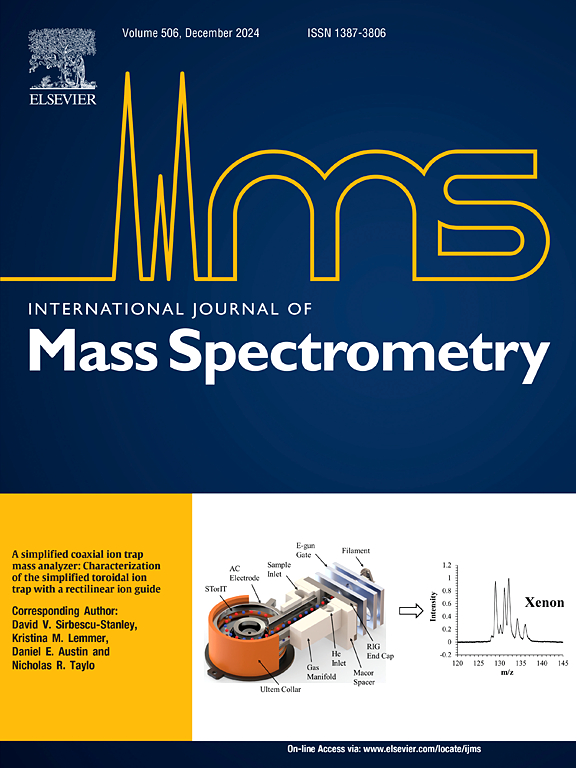Structure selective fragment ions of epoxidized sphingolipids
IF 1.7
3区 化学
Q3 PHYSICS, ATOMIC, MOLECULAR & CHEMICAL
引用次数: 0
Abstract
Sphingolipids are essential building blocks of most organisms. The structure of sphingolipids is tightly regulated and dysregulation during diseases can result in altered sphingolipid structures. In this manuscript, we explore the potential of sphingolipid epoxidation for the assignment and discrimination of sphingolipid structures. Employing shotgun tandem mass spectrometry, liquid chromatography tandem mass spectrometry, authentic sphingolipid standards, and density function theory, we demonstrate that epoxidation of shingoid bases (SPBs), ceramides, and sphingomyelins facilitates C=C bond (DB) position assignment. This includes DBs in the N-linked fatty acyl moiety and the sphingoid base. For SPBs with DBs at position 4, a major component for almost all sphingolipids, we furthermore demonstrate that the fragmentation pathway differs for this DB position compared to other DB-diagnostic fragment ions. We show that epoxidation of this DB position facilities intramolecular rearrangement and formation of distinct diagnostic fragment ions. To demonstrate the analytical capabilities and show that the 4 SPB DBs enable confident differentiation of ceramides and dihydroceramides, results for brain ceramide extract are presented. The identified fragmentation pathway for 4 SPB DB ions in combination with N-acyl assignment and DB position assignment allows to annotate 25 ceramide/dihydroceramide compounds in the brain ceramide extract out of which 23 are DB position isomers.

环氧鞘脂结构选择性片段离子
鞘脂是大多数生物体必不可少的组成部分。鞘脂结构受到严格调控,疾病期间的失调可导致鞘脂结构改变。在这篇论文中,我们探讨了鞘脂环氧化对鞘脂结构的分配和辨别的潜力。利用霰弹枪串联质谱法、液相色谱串联质谱法、真实鞘脂标准和密度函数理论,我们证明了鞘鞘碱(SPBs)、神经酰胺和鞘磷脂的环氧化有助于C=C键(DB)的位置分配。这包括在n -连接的脂肪酰基部分和鞘碱的db。对于位于4号位置(几乎所有鞘脂的主要成分)的spb,我们进一步证明了与其他DB诊断片段离子相比,该DB位置的碎片路径不同。我们发现这个DB位置的环氧化有助于分子内重排和形成不同的诊断片段离子。为了证明分析能力,并表明4个SPB db能够自信地区分神经酰胺和二氢神经酰胺,给出了脑神经酰胺提取物的结果。结合n -酰基分配和DB位置分配,确定了4个SPB - DB离子的碎片化途径,允许在脑神经酰胺提取物中注释25个神经酰胺/二氢神经酰胺化合物,其中23个是DB位置异构体。
本文章由计算机程序翻译,如有差异,请以英文原文为准。
求助全文
约1分钟内获得全文
求助全文
来源期刊
CiteScore
3.60
自引率
5.60%
发文量
145
审稿时长
71 days
期刊介绍:
The journal invites papers that advance the field of mass spectrometry by exploring fundamental aspects of ion processes using both the experimental and theoretical approaches, developing new instrumentation and experimental strategies for chemical analysis using mass spectrometry, developing new computational strategies for data interpretation and integration, reporting new applications of mass spectrometry and hyphenated techniques in biology, chemistry, geology, and physics.
Papers, in which standard mass spectrometry techniques are used for analysis will not be considered.
IJMS publishes full-length articles, short communications, reviews, and feature articles including young scientist features.

 求助内容:
求助内容: 应助结果提醒方式:
应助结果提醒方式:


